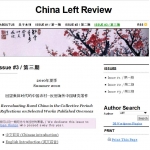Articles tagged with: Great Leap Forward
Great Leap Forward, Reviews »

Excerpts from Cormac Ó Gráda’s review of new book by Dikötter, Mao’s Great Famine. “MGF may become the best-known account of the GLF famine for a while. But should it? It is not a comprehensive account of the famine; it is dismissive of academic work on the topic; it is weak on context and unreliable with data; and it fails to note that many of the horrors it describes were recurrent features of Chinese history during the previous century or so…”
China Left Review, Chinese Revolutionary History, CSG Announcements »

Issue #3 of China Study Group’s bi-lingual web-journal China Left Review is focused on new essays, by Chinese and overseas writers, revisiting several English-language books about rural China during the collective/ “people’s commune” era (ca. 1957-1982). The issue also includes an article on China’s ongoing land-tenure debate, and one on Sino-Korean relations. With the exception of the latter article, every text is presented in both Chinese and English versions - a first for this journal which we hope to continue. (If you’d like to help out with translating, revising or writing for future issues, please contact [email protected].) Also note the new design of the CLR website, including the painting “Iron Bones Giving Birth to Spring” (铁骨生春).
China Studies, Great Leap Forward, Rural China »
Utsa Patnaik: “On Famine and Measuring ‘Famine Deaths.’” Thinking Social Science in India: Essays in Honour of Alice Thorner. Ed. Sujata Patel, Jasodhara Bagchi, and Krishna Raj. New Delhi: Sage, 2002.
This is a long, dense and rigorous critique of the ways in which the death toll of the Great Leap Forward famine has been produced or ‘socially constructed.’ More specifically it is a sustained engagement with the so-called pioneering work of Banister, Coale and Amartya Sen on the issue. From the inclusion of the “unborn” among the famine …
China Studies, Chinese Revolutionary History, Great Leap Forward »
Many developing countries which have a high proportion of poor in their population, are typically characterised by a high death rate as well as a high birth rate, with the birth rate exceeding the death rate. The rate of natural increase is given by the difference between the birth rate and the death rate. The actual increase of population is obtained by subtracting from this the net out-migration from the country, if any. In the course of development as health services reach a larger segment of the population, education levels improve and per head real incomes rise, it is expected that not only will the death rate come down but so will the birth rate. The aim is to obtain an even faster decline in the birth rate than in the death rate, if the rate of natural increase is to come down from initial high levels. China however although starting from a worse situation had lowered both the death rate and the birth rate much faster.

